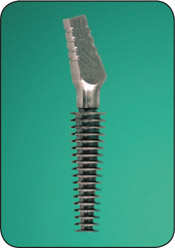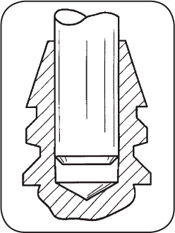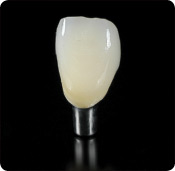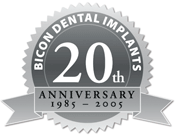History
 The Bicon System has its origins dating back to 1968. Initial research was conducted at Battelle Memorial Institute in Columbus, Ohio by Thomas Driskell. The original implant design of Mr. Driskell used high density aluminum
The Bicon System has its origins dating back to 1968. Initial research was conducted at Battelle Memorial Institute in Columbus, Ohio by Thomas Driskell. The original implant design of Mr. Driskell used high density aluminum
oxide as the implant material. In 1981, Driskell introduced an implant named Titanodont which was made from titanium alloy. Then, in 1985, he perfected his titanium implant design by patenting the DB Precision Implant, which is known today as the Bicon Dental Implant System. Whether Driskell knew it or not at the time he developed this implant system, his design coupled with the clinical support of Bicon has come to revolutionize implant dentistry in the 21st century.
1968: Thomas Driskell, Inventor of the Bicon System

Thomas Driskell initiates his dental implant research.
US Army Medical Research and Development Command Dental Research Division funds the development of a free standing single tooth replacement implant that could be placed into a fresh extraction site, and the development of synthetic bone grafting materials for the repair of avulsive wounds.
« Previous | Next »
1970: The Plateau Design

Studies reveal highly effective load transmission from the plateau design implant to the surrounding bone by means of an osseointegrated multi-finned design. This design was shown to be inherently more effective for the distribution of occlusal forces to the bone than screws or any other mechanical load transmitting design used by other implant manufacturers.
Driskell demonstrates histologically a direct bone to implant interface using free-standing tooth implants in Rhesus Monkeys. This phenomenon is now known as osseointegration.
Initial research begins on Beta-Tricalcium Phosphate, a synthetic bone graft material.
« Previous | Next »
1975: Synthodont Implant Design

Driskell introduces the Synthodont implant. It is the first truly successful, free-standing osseointegrated single tooth dental implant, specifically designed and sold for use in humans on a large scale, which has a one piece, non-submergible design.
« Previous | Next »
1982: Titanodont Implant Design

Driskell introduces the Titanodont implant, made of titanium alloy (Ti6Al4V-ELI) incorporating the same design features as the Synthodont.
FIRST Mechanically textured and acid etched bone/implant surfaces.
FIRST Complete interchangeability of abutment diameters, providing sensible biological width and offering
the concept now being described as platform switching.
FIRST Locking taper implant to abutment connection providing 360° of universal abutment positioning and a bacterial seal.
« Previous | Next »
1985: Bicon Implant Design

Bicon’s implant system is introduced, including highly successful 8.0mm length implants which were considered very short at the time.
FIRST Grit-blasted, acid-treated, passivated implants in sterile packaging, known today as Bicon’s Integra-Ti™.
FIRST Titanium instrumentation.
FIRST Unique, 50RPM low-speed drills for socket preparation which harvest bone and do not require irrigation.
FIRST Unique sloping shoulder concept designed to help maintain crestal bone height and interdental papillae.
« Previous | Next »
1997: 6.0 x 5.7mm Implant

6.0 x 8.0mm implant is introduced and receives FDA clearance.
Clinical studies begin for the shortest implant available on the market today: Bicon’s 5.7mm SHORT® Implant.
« Previous | Next »
2001: Integrated Abutment Crown™

FIRST Integrated Abutment Crown™ (IAC) as well as the promotion of extra oral cementation of crowns.
« Previous | Next »
2004: 5.0 x 6.0mm SHORT® Implant

5.0 x 6.0mm SHORT® Implant is introduced and receives FDA clearance.
« Previous | Next »
2005: 20-Year Anniversary

Bicon celebrates the 20-year anniversary of its implant design.
Bicon introduces the Brevis™ Overdenture System.
A new formulation of SynthoGraft™ pure phase Beta-Tricalcium Phosphate is introduced.
« Previous | Next »
2007: New Headquarters

Completion of Bicon’s state-of-the-art clinical and teaching facility.
4.5 x 6.0mm SHORT® Implant is introduced and receives FDA clearance.
« Previous | Next »
2008: New SHORT® Implants

6.0 x 5.0mm SHORT® Implant is introduced and receives FDA clearance.
5.0 x 5.0mm SHORT® Implant is introduced and receives FDA clearance.
« Previous | Next »
 The Bicon System has its origins dating back to 1968. Initial research was conducted at Battelle Memorial Institute in Columbus, Ohio by Thomas Driskell. The original implant design of Mr. Driskell used high density aluminum
The Bicon System has its origins dating back to 1968. Initial research was conducted at Battelle Memorial Institute in Columbus, Ohio by Thomas Driskell. The original implant design of Mr. Driskell used high density aluminum









